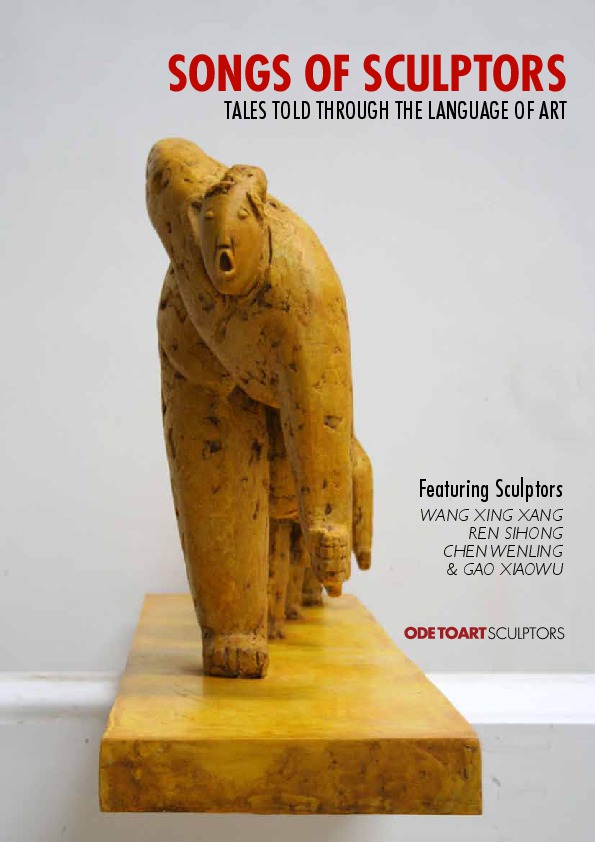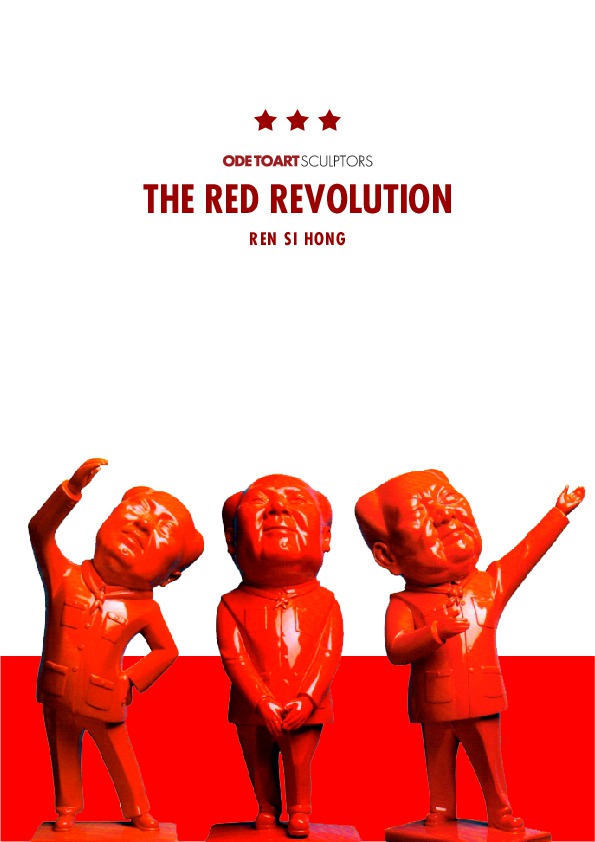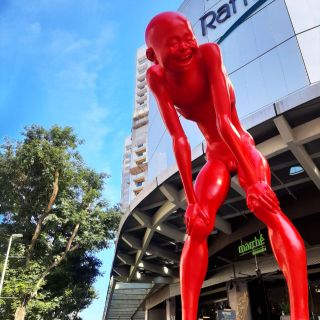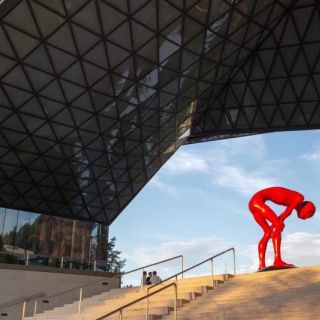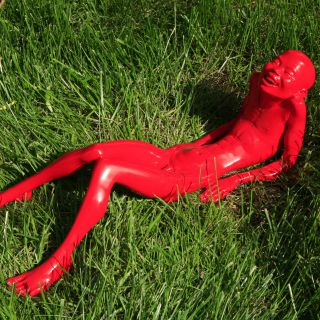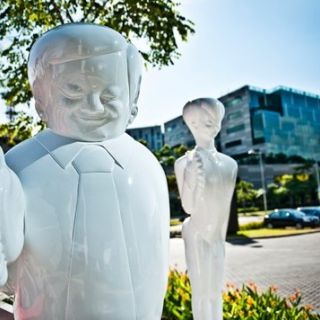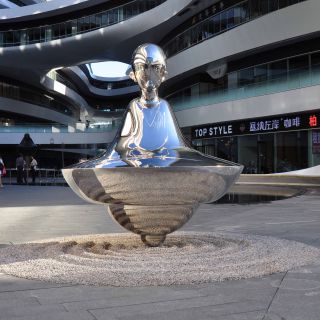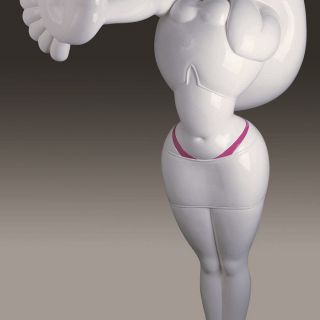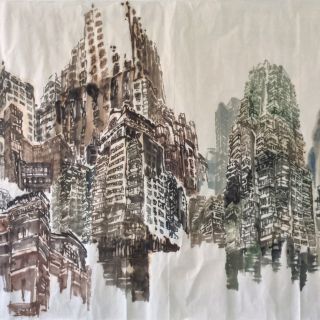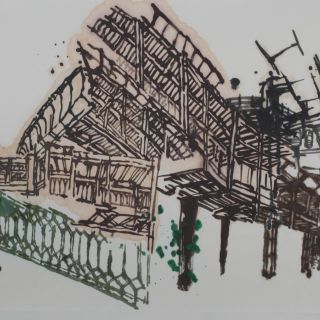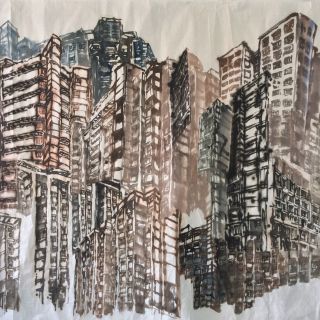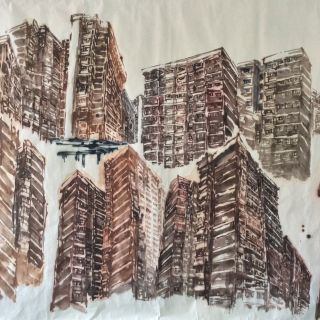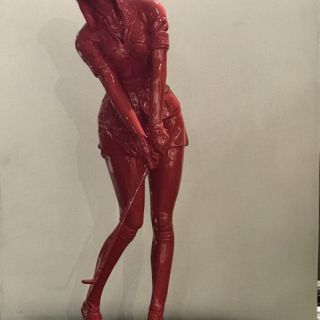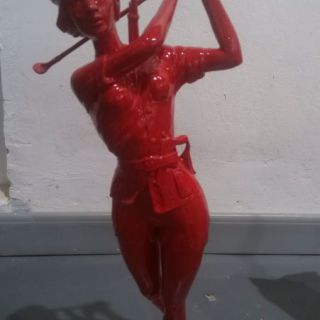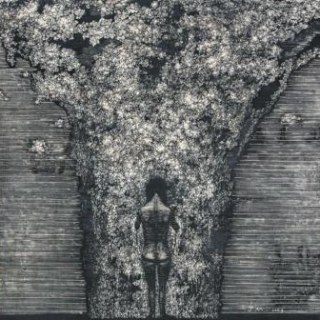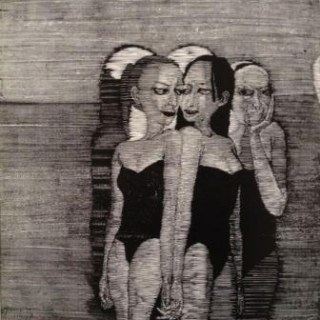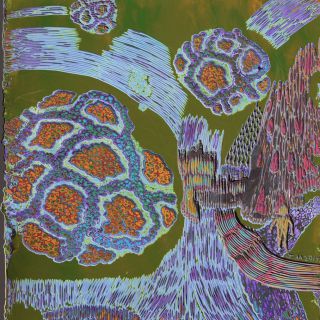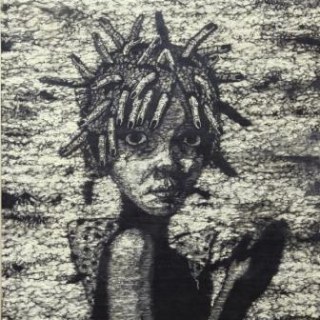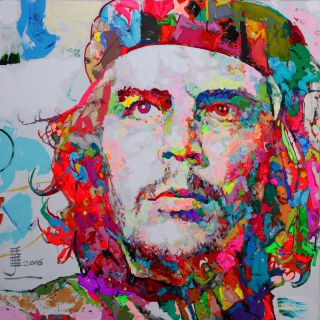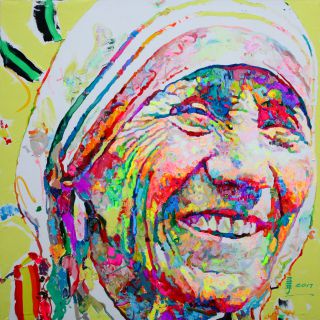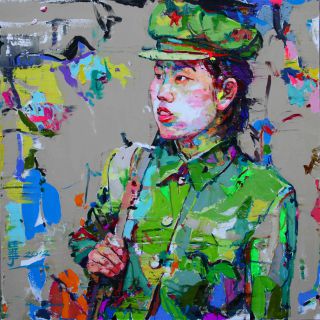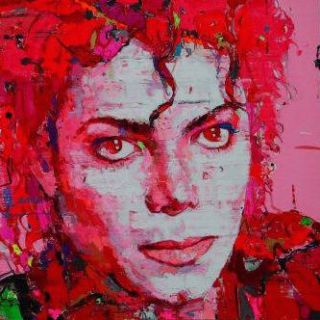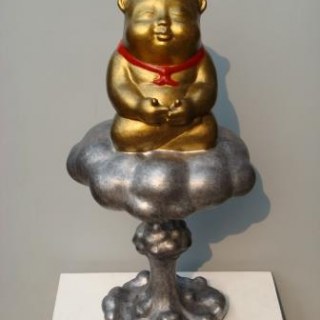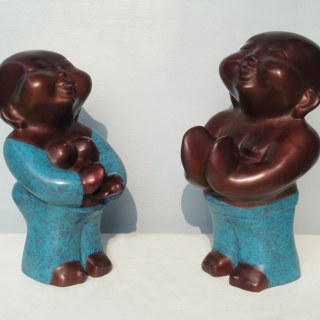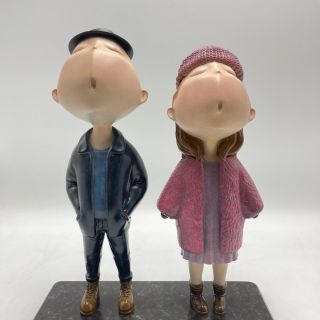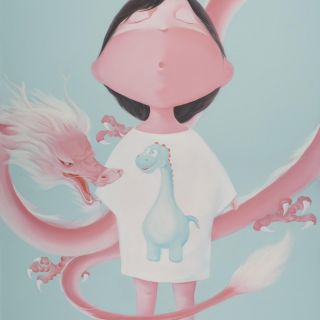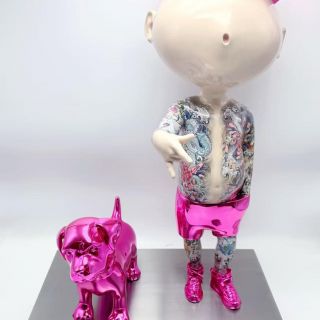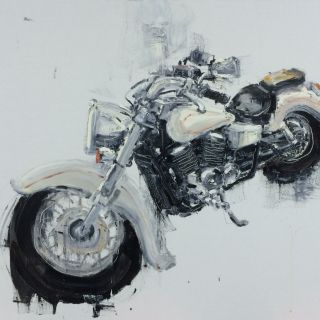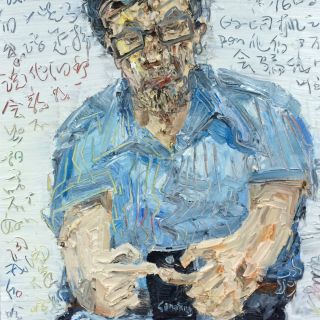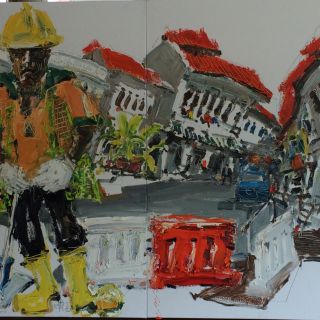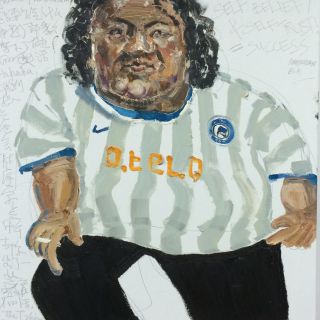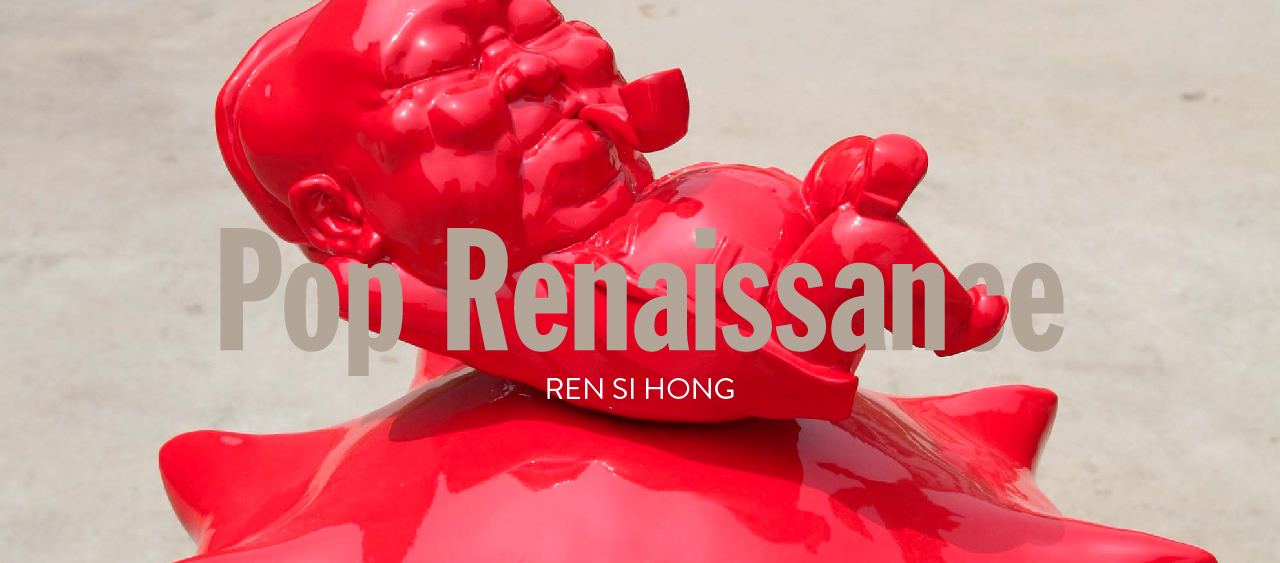
Ren Sihong (born in 1967) graduated from the Fine Art Department of Hebei Normal College in 1991. From 1991 to 1993, he studied in the Teaching Assistant Program for the Oil Painting Class in Central Academy of Fine Arts. In 1993, his solo exhibition was held in the Central Academy's gallery. He now works as a professional painter. Ren's work can be classified as Political Pop, in which the great leader is presented in such a lighthearted and humorous way that the distance between the untouchable, glorified giant and our realistic experience vanishes. In the sculpture ensemble, Mao leads the children of the consumer society in carrying out the broadcast exercise. He turns the uniformity of the exercise movement into free and idle self-entertaining behavior which brings a post-ideological linguistic feature to politics and sports.
Viewing 8 works by Ren Si Hong
Sort
Biography 
Biography
Ren Sihong (born in 1967) graduated from the Fine Art Department of Hebei Normal College in 1991. From 1991 to 1993, he studied in the Teaching Assistant Program for the Oil Painting Class in Central Academy of Fine Arts. In 1993, his solo exhibition was held in the Central Academy's gallery. He now works as a professional painter. It is impossible to fully interpret Ren Sihong's works without two substantial elements. One is the political past of China and its extensive effect on artistic creation from the Cultural Revolution to current day. And secondly, it is the artist himself.
Although Chinese Political Pop Art can trace its roots from American Pop Art, the context in which the political pop works emerge is far more complex than that of the west. The Cultural Revolution, which inspired great works of political nature, was a period in history that caused great upheaval in China and Mao Zedong was synonymous with that regime. Chairman Mao is the symbol of a totalitarian regime where politics saturated all aspects of life. Essentially, the entire populace was affected and this included all forms of artistic expression being limited.
The end of the revolution saw two distinct forms of art emerging - cynical realist art and political pop art. These works tended to be social commentaries of the past and the present. With the revolution divested of its power, Chinese artists who once created propaganda posters, willingly or forcefully, were now able to express themselves in unprecedented forms. For many artists who lived through those times, the process of creation and more importantly, of satirical expressions of Mao, is a form of exorcism of that past - a means to secularise a god.
This is clearly seen in Ren Sihong sculptures and paintings of the political leader. We see Mao Zedong with an exaggerated head, smiling whilst doing a gymnastic action or with sunglasses standing to attention or even taking a nap on the 'Red Book'. Mao is basically treated in various positions in a manner that is an obvious caricature. His paintings too have the same absurd quality to it. In the footsteps of many prominent names before him, Ren interprets 'his' Mao in a manner that is intimate to him. It is essential then to realise that the painter cannot be disassociated from his works. As much as his art is a critical commentary, it resonates the persona of the artist. It is more than a disengaged insight - it is a personal reaction and a reflection of the quaint and comical nature of the artist manifested through his art. Knowing this, the whimsical character of his works becomes self-explanatory.
Although Chinese Political Pop Art can trace its roots from American Pop Art, the context in which the political pop works emerge is far more complex than that of the west. The Cultural Revolution, which inspired great works of political nature, was a period in history that caused great upheaval in China and Mao Zedong was synonymous with that regime. Chairman Mao is the symbol of a totalitarian regime where politics saturated all aspects of life. Essentially, the entire populace was affected and this included all forms of artistic expression being limited.
The end of the revolution saw two distinct forms of art emerging - cynical realist art and political pop art. These works tended to be social commentaries of the past and the present. With the revolution divested of its power, Chinese artists who once created propaganda posters, willingly or forcefully, were now able to express themselves in unprecedented forms. For many artists who lived through those times, the process of creation and more importantly, of satirical expressions of Mao, is a form of exorcism of that past - a means to secularise a god.
This is clearly seen in Ren Sihong sculptures and paintings of the political leader. We see Mao Zedong with an exaggerated head, smiling whilst doing a gymnastic action or with sunglasses standing to attention or even taking a nap on the 'Red Book'. Mao is basically treated in various positions in a manner that is an obvious caricature. His paintings too have the same absurd quality to it. In the footsteps of many prominent names before him, Ren interprets 'his' Mao in a manner that is intimate to him. It is essential then to realise that the painter cannot be disassociated from his works. As much as his art is a critical commentary, it resonates the persona of the artist. It is more than a disengaged insight - it is a personal reaction and a reflection of the quaint and comical nature of the artist manifested through his art. Knowing this, the whimsical character of his works becomes self-explanatory.
Exhibitions 
Exhibitions
2014
Betterlife Space, Beijing, China
2009
The Red Revolution, Ode To Art, Singapore
Songs of Sculptors, Ode To Art, Singapore (Group show)
2007
Contemporary Art Show, 501 Art Base, Chong Qing, China
Collection Exhibition, DUANLUO Space Gallery, Beijing, China
2006
Marchina Arte Contemporanea, Brescia, Italy
Exhibition, 798 Gallery, New York, USA,
"Made in China" Exhibition, Italy
"Brother" Exhibition, Beijing, China
"Beijing Artistic Literature Exhibition", Beijing, China
2005
"She Shi Dai" Exhibition, Tianjin, China
2004
"China's Ten Contemporary Artists" Oil Exhibition
Composed 'An Quan Bu Sheng Chan' with writer, Dai Zi
2000
Composed 'DaVinci Balcony'
1993
Central Academy of Fine Arts, China
Betterlife Space, Beijing, China
2009
The Red Revolution, Ode To Art, Singapore
Songs of Sculptors, Ode To Art, Singapore (Group show)
2007
Contemporary Art Show, 501 Art Base, Chong Qing, China
Collection Exhibition, DUANLUO Space Gallery, Beijing, China
2006
Marchina Arte Contemporanea, Brescia, Italy
Exhibition, 798 Gallery, New York, USA,
"Made in China" Exhibition, Italy
"Brother" Exhibition, Beijing, China
"Beijing Artistic Literature Exhibition", Beijing, China
2005
"She Shi Dai" Exhibition, Tianjin, China
2004
"China's Ten Contemporary Artists" Oil Exhibition
Composed 'An Quan Bu Sheng Chan' with writer, Dai Zi
2000
Composed 'DaVinci Balcony'
1993
Central Academy of Fine Arts, China
Critique 
Critique
Mao Fills the Hollow: Artistic Repetition and the Call of the Future
What could be more appealing than the playful cool of Ren Shihong's miniaturized figures of Mao? Seemingly cashing in on the POPular artistic appropriation of Mao by so many of his Chinese peers, Ren seduces his viewers with humorous clusters of knee-high figures of the cultural hero, gleaming brightly in a sheen of Chinese red. One set of smiling figures portrays Mao in various positions of aerobic exercise. His apparent ease with the difficult tasks of daily workouts suggests the pleasure and benefit derived from regular workouts and bodily control. Another set of figures presents a giggling Mao as the beneficent bearer of gifts to his viewers, this time dressed parodically as Santa Claus, that Western patron of childish pleasure.
Even in the sensations of cool and Pop cast by his acrylic red figures, Ren's prodigious production makes clear that there's a deeply serious side to his performative love of play, humor, and parody. This stems from his strategic capitalization in form and content on the rhetorical force of repetition. It could be said the excessive replication of Mao in the studio of this prolific artist encourages reflection on the declining aura of this singular historical figure. Consider the impact on viewers of the gleefully aerobic Mao when the multiple sets of this figure who assumes some twelve different postures are juxtaposed with the historical photograph from which the series derives. Ren drew his artistic inspiration not from the myriad statues of Mao that seem to appear in almost every venue of contemporary Chinese art. Instead he dialogues with a withered black and white photograph that displays a group of youths being led in required daily calisthenics during the Cultural Revolution. The repetition of exercise evokes not merely the intense pleasure of physical exertion, as evoked by his gleeful figures of Mao, but also the exhausting force of labor. The haunting presence of this photograph as an attestation of the historical real evokes thoughts not merely about the exciting rigor of exercise's repetition but also the numbing fatigue of indifferent participation, the distrustful craft of institutional discipline, and the potential boredom of communal conformity. Yet, even in the numerous sameness of his multiple editions, Ren sheds blandness for boldness. Ren's aesthetic reinvigorates discipline with the joy of participation, and repetition with an embrace of cultural difference. In transforming the bland colors of Mao's well-known jacket from military olive to cherry red, Ren insinuates his viewers in the joyful repetition of artistic difference itself.
Indeed, the vastness of Ren's artistic production works to insist bravely on the in-betweens of an aesthetics of difference. His viewers are solicited to remain attentive to the gaps and fissures that mark the passage of time, that denote the contrast of artistic mediums, and that highlight the disparities of wealth and opportunity made so evident by the explosive international popularity of contemporary Chinese art. When this visitor moved away from the seemingly predictable groupings of Mao at play in Ren's studio, he found the seductive tune of cool and Pop emitted by these glossy statues to give way to the enigma and pensiveness of a series of weighty, bronzed sculptures, ranging in height from two to six feet. Here the earlier allusion to history gives shape to literal embodiments of learning and erudition in the guise of thick books, monumental gates, and performative figures.
Among the sculptures that seem almost to litter Ren's cavernous studio, the full-bodied figure of Mao returns, but this time doubled on top of each end of a book or bronzed Gate of Heavenly Peace, with one leg pirouetting outward in opposite directions on either side of the monument to raise questions of equilibrium. In another sculptural series, Ren positions Mao back-to-back with himself, so that he bears the weight of the Other. While this gestures to the code of beneficence so celebrated by the Revolutionary tradition it also hints at the inequality of distribution. Some carry, while others are carried. Some like Ren himself have new means of capital to bear the burdens of the State, while others find something wanting, dependent, and burdensome.
And while Mao's doubled figure could emit the comforting promise of the stable balance of the State, it could just as easily evoke the opposing spectrum of meaning, which remains delicately poised in perilous tension. So it goes that Ren's figuration of Mao, which is so clearly parodic and beneficent in the red Santa Claus series, invokes something of value and depth when finished in polished bronze. The Mao-in-balance assumes a pensive quality as if foregrounding the perilousness of balance itself, as if there could be two versions of the same history with one potentially bearing more weight than the other.
Just as the massively strong statues of Mao dwarf playfully parodic miniatures in Ren's studio, the visitor is confronted by colossal sculptures of books, gates, and figures whose enormity begs for reflection. This is particularly true of Ren's large sculptures of thick books finished in bronze or polished steel, whether standing on end or sprawled across the floor with pages open. What's striking about these massive books, whose thickly gird magnifies the proportions of their height, is the irregularity of hallow cut-outs that leave their centers empty. These shapes seem almost anamorphically irregular in many pieces until, that is, they are seen from an angle that reveals the cut-out profile of Mao in some or of Tiananmen Square's Gate of Heavenly Peace in others. Evinced by these cutouts is the enigma of the cavity itself, as if the figure of Mao or Tiananmen empties out, hollows, or fills the space of bookish learning. Consistent throughout is the repetitious specter of this hollow itself. Whether in the apparatus of learning or the architectonics of governance, the void makes its presence known as if speaking from deep within the tombs of learning or the forbidden spaces of empire. Yet, the hollow functions here not as something empty or missing but as a shapely container of possibility and becoming, as the ample core of perspective, as the philosopher's stone of art and culture.
It is not surprising, then, that Ren understands his books to serve "education about the future." Indeed, he proudly reminds visitors to his studio that even the surface of the sculptures themselves will change over time, as the bronze patinas morph in color due to contact with their stroking admirers. Ren's works in bronze thus solicit and appeal to contact in future. Instead of signifying the melancholic passage of the historical past, they confidently perform the evolution of Maoist idealism in the becoming of the future. Perhaps this explains the seemingly random inscriptions chiseled onto the façade of Ren's colossal sculpture of a hallow book, roughly 8 feet by 12 feet. The bold assertion of the mottos of the past, "realism," "strength," "struggle," and "revolution," stand juxtaposed and/or get thrown into turmoil by loud slogans of the future: "freedom,' "direction," "seeking truth," not to mention the most prominent word at the top, "Democracy."
The bookish specter of the hollow and its less than subtle allusion to the challenges posed by recent Chinese history is even depicted further by Ren's large scale paintings. While the hollowness of his sculpture gives way to the flatness of his painting, the viewer continues to be hailed by the enigma of Ren's repetitious imagery. In some paintings, the hollow seems to take on the guise of fantastical landscapes that envelope a joyous Mao who dances in sport and play, as if celebrating freedom's call of the future. In others, Mao walks amidst paths of an impressionist palette of magenta, orange, pink, blue, and green that surround the grey-jacketed Leader whose flush red face figures both the glorious past and its enigmatic relation to the future. Exertion or exhaustion? And in two massive paintings of Tiananmen, and my personal favorites, the specter of the public space is populated by an abundance of randomly placed figures that drip with red paint, abstracted human figures in one, anthropomorphic books in another. Here the display of knowledge, history, and human presence enlivens and emboldens the Square whose vastness is condensed by Ren's smaller sculptures into miniaturized totems of monumentality. Both in medium and scale, Ren Shihong's artistic craft spins two different tales of the same history. One monumental, another spectral. One solid, another empty. One expansive, another restrictive. One cast solidly for the future in bronze, the other dripping tenuously in the present with fresh appearing paint whose redness fills the Square of Tiananmen to suggest yet again a Tale of Two Cities, one from the past and another for the future. And while the scale of these monumental paintings harkens back to an age when art stood proud in the service of the people, the reddened abstraction of their figures now raise ontological questions about the people themselves. Who will be the Chinese to fill the Tiananmen Square of the future. Who will constitute the people, the patrons, and, yes, even the producers of art?
The urgency of this question takes on somewhat of a darker cast in another series of smaller scale bronzes. These pieces confront their viewers with the full frontal view of a nude female who lies on her back while thrusting out her pelvis with legs spread wide apart. Is this some bizarre homage to, say, Courbet's "The Origin of the World," whose starkly fetishistic presentation of female genitalia confronts the viewer with art's celebration of origins, of motherhood, of genius or of artistic aura itself? Or does it make a more perversely pornographic statement regarding the scopophiliac pleasure of the gaze and its disproportionately gendered force and violence? The key to this coda lies in the flesh itself, this time in the disproportionate volume of the woman's legs. The same pubic source is framed by exceptionally different extremities, one rather emaciated and fragile, the other loudly opulent and luxuriant. Once viewers get over the extreme pleasure, shock or anger received from such a fully frontal confrontation with Ren's artistic labia, they find themselves faced head on, once again, with two different appendages to the same tale. The frame of perspective her delivers only the prosthesis of uneven access to the future, to liberty, and even to art.
In Ren's most extravagant sculptural installation, now in progress, his visitors will find themselves engulfed within the very space of cultural representation that the smaller pieces ask them to contemplate from a distance, from afar, from without. Here Ren's visitors are dwarfed by a huge replica of the Gate of Heavenly Peace and by an exceptionally colossal statue of a buoyantly nude mother goddess whose bulbous flesh suggests either a voluptuousness without bounds or a cancerousness run amok. In another zone of the studio, the perilous balance between pleasure and pain seems to be safeguarded by an energetic dragon who disproportionate, multi-bodied headdress sports thirteen statues of Mao in various facial expressions. The Mao at the center holds the hydra's tentacles as if Santa Mao driving his reindeer. It is within this combined environment of classical Chinese tradition, Modern Maoism, and Postmodern Pop that Ren's the visitors are invited to lend their fate. Once again in the aesthetic repetition of Ren Shihong, it is Mao who fills the hallow. Only this time he's not predictably dressed in glossy red, but in an uneven bronze whose changing patina awaits its contact with the future.
Timothy Murray
Curator of the Rose Goldsen Archive of New Media Art and Professor of Comparative Literature and English at Cornell University, Ithaca, New York.
Sihong, Ren: The Culture Characters of the "Cute Mao" and the Period of "Post-Mao"
Starting from 1990, China entered the "post-Mao" period. The use of Mao's portraits and images, and socialist cultural images in the Mao period has become mainstream in Chinese contemporary art. Sihong Ren's recent art works rely mainly on cultural resources from the Mao period. His main two series are "Broadcast Exercise" and "Great Olympic".
Mao emphasised continual campaigns and the Broadcast Exercise under Mao's regime takes on a new meaning in Sihong Ren's art works. "Broadcast Exercise" (2005) is a series sculpture, which represents a group of contemporary and fashionable people doing "Broadcast Exercise". "Great Olympic" is a painting series. It shows different kinds of cute Maos playing with swords, and engaging in football, basketball, Tai Chi, and piano practice.
In fact, "Great Olympic" was a great exploitation of Mao images in the 1990s. This series has two new meanings. One is to make Mao's images cute. Another one is the character, signifying the place between campaign and political culture. By the end of the 1990s, the way to represent Mao had already progressed from blind idol worship to sarcasm and a disassembling of godhood. The images of Mao gradually became neutral and more humanized. Mao's images now have a symbolic connection with Kwanyin Boddhisattva, family heroes, and contemporary officers who approve of capitalism and entertainment to a certain degree. The images of Mao in Sihong Ren's art work make a sharp break with Mao's historical image. The images of Mao have become humanized and cute. It seems that he has temporarily discarded the heavy burden of saving history and representing cruel reality, in order to enjoy a happy, carefree lifestyle.
Making Mao cute reveals that people have chosen a special self-survival mode, which is that people no longer revolt, instead searching for relief, in order to adapt to the new consumerist social system. This new consumer society has forced people to make this choice, a choice that has become the new generation's core character and concept of value. Wealth, health, exercise, esthetic sense and entertainment can all be found in Sihong Ren's art work. Meanwhile, Sihong Ren adopts exaggerated elements from Hong Kong movies.
Sport also played a very important role in the Mao period. It was an instrument and expression of the new political reality, as were broadcast exercises. Both were forceful, regulated, and full of group slogans. They trained the public to have discipline and obedience.
The title, "Great Olympic", also has special meanings. It emphasizes the special meanings of body and Olympic sport in Chinese politics after the 1990s, and the connection between the Mao period, post-Mao period and modern age. Moreover, this title has a strong connotation with the 2008 Olympic Games. Ren Si Hong regards Olympic sport in the 1990s as a kind of benign politics. Although Olympic sport was also an instrument of politics it was a healthy instrument because it brought Olympic related economic profit and improved China's international image.
Although Ren Si Hong has used many funny Mao images, he has two main aims. One is to make Mao's images cute. The other is to humanize them. This shows that there is still lots of room to use Mao's images and resources and China still hasn't entirely departed from the Mao period. Mao visual forms still have emblematic game space and Ren Si Hong's work increases the possibility of Mao's definitive image.
Zhu Qi
Wangjing on May 27th, 2006
What could be more appealing than the playful cool of Ren Shihong's miniaturized figures of Mao? Seemingly cashing in on the POPular artistic appropriation of Mao by so many of his Chinese peers, Ren seduces his viewers with humorous clusters of knee-high figures of the cultural hero, gleaming brightly in a sheen of Chinese red. One set of smiling figures portrays Mao in various positions of aerobic exercise. His apparent ease with the difficult tasks of daily workouts suggests the pleasure and benefit derived from regular workouts and bodily control. Another set of figures presents a giggling Mao as the beneficent bearer of gifts to his viewers, this time dressed parodically as Santa Claus, that Western patron of childish pleasure.
Even in the sensations of cool and Pop cast by his acrylic red figures, Ren's prodigious production makes clear that there's a deeply serious side to his performative love of play, humor, and parody. This stems from his strategic capitalization in form and content on the rhetorical force of repetition. It could be said the excessive replication of Mao in the studio of this prolific artist encourages reflection on the declining aura of this singular historical figure. Consider the impact on viewers of the gleefully aerobic Mao when the multiple sets of this figure who assumes some twelve different postures are juxtaposed with the historical photograph from which the series derives. Ren drew his artistic inspiration not from the myriad statues of Mao that seem to appear in almost every venue of contemporary Chinese art. Instead he dialogues with a withered black and white photograph that displays a group of youths being led in required daily calisthenics during the Cultural Revolution. The repetition of exercise evokes not merely the intense pleasure of physical exertion, as evoked by his gleeful figures of Mao, but also the exhausting force of labor. The haunting presence of this photograph as an attestation of the historical real evokes thoughts not merely about the exciting rigor of exercise's repetition but also the numbing fatigue of indifferent participation, the distrustful craft of institutional discipline, and the potential boredom of communal conformity. Yet, even in the numerous sameness of his multiple editions, Ren sheds blandness for boldness. Ren's aesthetic reinvigorates discipline with the joy of participation, and repetition with an embrace of cultural difference. In transforming the bland colors of Mao's well-known jacket from military olive to cherry red, Ren insinuates his viewers in the joyful repetition of artistic difference itself.
Indeed, the vastness of Ren's artistic production works to insist bravely on the in-betweens of an aesthetics of difference. His viewers are solicited to remain attentive to the gaps and fissures that mark the passage of time, that denote the contrast of artistic mediums, and that highlight the disparities of wealth and opportunity made so evident by the explosive international popularity of contemporary Chinese art. When this visitor moved away from the seemingly predictable groupings of Mao at play in Ren's studio, he found the seductive tune of cool and Pop emitted by these glossy statues to give way to the enigma and pensiveness of a series of weighty, bronzed sculptures, ranging in height from two to six feet. Here the earlier allusion to history gives shape to literal embodiments of learning and erudition in the guise of thick books, monumental gates, and performative figures.
Among the sculptures that seem almost to litter Ren's cavernous studio, the full-bodied figure of Mao returns, but this time doubled on top of each end of a book or bronzed Gate of Heavenly Peace, with one leg pirouetting outward in opposite directions on either side of the monument to raise questions of equilibrium. In another sculptural series, Ren positions Mao back-to-back with himself, so that he bears the weight of the Other. While this gestures to the code of beneficence so celebrated by the Revolutionary tradition it also hints at the inequality of distribution. Some carry, while others are carried. Some like Ren himself have new means of capital to bear the burdens of the State, while others find something wanting, dependent, and burdensome.
And while Mao's doubled figure could emit the comforting promise of the stable balance of the State, it could just as easily evoke the opposing spectrum of meaning, which remains delicately poised in perilous tension. So it goes that Ren's figuration of Mao, which is so clearly parodic and beneficent in the red Santa Claus series, invokes something of value and depth when finished in polished bronze. The Mao-in-balance assumes a pensive quality as if foregrounding the perilousness of balance itself, as if there could be two versions of the same history with one potentially bearing more weight than the other.
Just as the massively strong statues of Mao dwarf playfully parodic miniatures in Ren's studio, the visitor is confronted by colossal sculptures of books, gates, and figures whose enormity begs for reflection. This is particularly true of Ren's large sculptures of thick books finished in bronze or polished steel, whether standing on end or sprawled across the floor with pages open. What's striking about these massive books, whose thickly gird magnifies the proportions of their height, is the irregularity of hallow cut-outs that leave their centers empty. These shapes seem almost anamorphically irregular in many pieces until, that is, they are seen from an angle that reveals the cut-out profile of Mao in some or of Tiananmen Square's Gate of Heavenly Peace in others. Evinced by these cutouts is the enigma of the cavity itself, as if the figure of Mao or Tiananmen empties out, hollows, or fills the space of bookish learning. Consistent throughout is the repetitious specter of this hollow itself. Whether in the apparatus of learning or the architectonics of governance, the void makes its presence known as if speaking from deep within the tombs of learning or the forbidden spaces of empire. Yet, the hollow functions here not as something empty or missing but as a shapely container of possibility and becoming, as the ample core of perspective, as the philosopher's stone of art and culture.
It is not surprising, then, that Ren understands his books to serve "education about the future." Indeed, he proudly reminds visitors to his studio that even the surface of the sculptures themselves will change over time, as the bronze patinas morph in color due to contact with their stroking admirers. Ren's works in bronze thus solicit and appeal to contact in future. Instead of signifying the melancholic passage of the historical past, they confidently perform the evolution of Maoist idealism in the becoming of the future. Perhaps this explains the seemingly random inscriptions chiseled onto the façade of Ren's colossal sculpture of a hallow book, roughly 8 feet by 12 feet. The bold assertion of the mottos of the past, "realism," "strength," "struggle," and "revolution," stand juxtaposed and/or get thrown into turmoil by loud slogans of the future: "freedom,' "direction," "seeking truth," not to mention the most prominent word at the top, "Democracy."
The bookish specter of the hollow and its less than subtle allusion to the challenges posed by recent Chinese history is even depicted further by Ren's large scale paintings. While the hollowness of his sculpture gives way to the flatness of his painting, the viewer continues to be hailed by the enigma of Ren's repetitious imagery. In some paintings, the hollow seems to take on the guise of fantastical landscapes that envelope a joyous Mao who dances in sport and play, as if celebrating freedom's call of the future. In others, Mao walks amidst paths of an impressionist palette of magenta, orange, pink, blue, and green that surround the grey-jacketed Leader whose flush red face figures both the glorious past and its enigmatic relation to the future. Exertion or exhaustion? And in two massive paintings of Tiananmen, and my personal favorites, the specter of the public space is populated by an abundance of randomly placed figures that drip with red paint, abstracted human figures in one, anthropomorphic books in another. Here the display of knowledge, history, and human presence enlivens and emboldens the Square whose vastness is condensed by Ren's smaller sculptures into miniaturized totems of monumentality. Both in medium and scale, Ren Shihong's artistic craft spins two different tales of the same history. One monumental, another spectral. One solid, another empty. One expansive, another restrictive. One cast solidly for the future in bronze, the other dripping tenuously in the present with fresh appearing paint whose redness fills the Square of Tiananmen to suggest yet again a Tale of Two Cities, one from the past and another for the future. And while the scale of these monumental paintings harkens back to an age when art stood proud in the service of the people, the reddened abstraction of their figures now raise ontological questions about the people themselves. Who will be the Chinese to fill the Tiananmen Square of the future. Who will constitute the people, the patrons, and, yes, even the producers of art?
The urgency of this question takes on somewhat of a darker cast in another series of smaller scale bronzes. These pieces confront their viewers with the full frontal view of a nude female who lies on her back while thrusting out her pelvis with legs spread wide apart. Is this some bizarre homage to, say, Courbet's "The Origin of the World," whose starkly fetishistic presentation of female genitalia confronts the viewer with art's celebration of origins, of motherhood, of genius or of artistic aura itself? Or does it make a more perversely pornographic statement regarding the scopophiliac pleasure of the gaze and its disproportionately gendered force and violence? The key to this coda lies in the flesh itself, this time in the disproportionate volume of the woman's legs. The same pubic source is framed by exceptionally different extremities, one rather emaciated and fragile, the other loudly opulent and luxuriant. Once viewers get over the extreme pleasure, shock or anger received from such a fully frontal confrontation with Ren's artistic labia, they find themselves faced head on, once again, with two different appendages to the same tale. The frame of perspective her delivers only the prosthesis of uneven access to the future, to liberty, and even to art.
In Ren's most extravagant sculptural installation, now in progress, his visitors will find themselves engulfed within the very space of cultural representation that the smaller pieces ask them to contemplate from a distance, from afar, from without. Here Ren's visitors are dwarfed by a huge replica of the Gate of Heavenly Peace and by an exceptionally colossal statue of a buoyantly nude mother goddess whose bulbous flesh suggests either a voluptuousness without bounds or a cancerousness run amok. In another zone of the studio, the perilous balance between pleasure and pain seems to be safeguarded by an energetic dragon who disproportionate, multi-bodied headdress sports thirteen statues of Mao in various facial expressions. The Mao at the center holds the hydra's tentacles as if Santa Mao driving his reindeer. It is within this combined environment of classical Chinese tradition, Modern Maoism, and Postmodern Pop that Ren's the visitors are invited to lend their fate. Once again in the aesthetic repetition of Ren Shihong, it is Mao who fills the hallow. Only this time he's not predictably dressed in glossy red, but in an uneven bronze whose changing patina awaits its contact with the future.
Timothy Murray
Curator of the Rose Goldsen Archive of New Media Art and Professor of Comparative Literature and English at Cornell University, Ithaca, New York.
Sihong, Ren: The Culture Characters of the "Cute Mao" and the Period of "Post-Mao"
Starting from 1990, China entered the "post-Mao" period. The use of Mao's portraits and images, and socialist cultural images in the Mao period has become mainstream in Chinese contemporary art. Sihong Ren's recent art works rely mainly on cultural resources from the Mao period. His main two series are "Broadcast Exercise" and "Great Olympic".
Mao emphasised continual campaigns and the Broadcast Exercise under Mao's regime takes on a new meaning in Sihong Ren's art works. "Broadcast Exercise" (2005) is a series sculpture, which represents a group of contemporary and fashionable people doing "Broadcast Exercise". "Great Olympic" is a painting series. It shows different kinds of cute Maos playing with swords, and engaging in football, basketball, Tai Chi, and piano practice.
In fact, "Great Olympic" was a great exploitation of Mao images in the 1990s. This series has two new meanings. One is to make Mao's images cute. Another one is the character, signifying the place between campaign and political culture. By the end of the 1990s, the way to represent Mao had already progressed from blind idol worship to sarcasm and a disassembling of godhood. The images of Mao gradually became neutral and more humanized. Mao's images now have a symbolic connection with Kwanyin Boddhisattva, family heroes, and contemporary officers who approve of capitalism and entertainment to a certain degree. The images of Mao in Sihong Ren's art work make a sharp break with Mao's historical image. The images of Mao have become humanized and cute. It seems that he has temporarily discarded the heavy burden of saving history and representing cruel reality, in order to enjoy a happy, carefree lifestyle.
Making Mao cute reveals that people have chosen a special self-survival mode, which is that people no longer revolt, instead searching for relief, in order to adapt to the new consumerist social system. This new consumer society has forced people to make this choice, a choice that has become the new generation's core character and concept of value. Wealth, health, exercise, esthetic sense and entertainment can all be found in Sihong Ren's art work. Meanwhile, Sihong Ren adopts exaggerated elements from Hong Kong movies.
Sport also played a very important role in the Mao period. It was an instrument and expression of the new political reality, as were broadcast exercises. Both were forceful, regulated, and full of group slogans. They trained the public to have discipline and obedience.
The title, "Great Olympic", also has special meanings. It emphasizes the special meanings of body and Olympic sport in Chinese politics after the 1990s, and the connection between the Mao period, post-Mao period and modern age. Moreover, this title has a strong connotation with the 2008 Olympic Games. Ren Si Hong regards Olympic sport in the 1990s as a kind of benign politics. Although Olympic sport was also an instrument of politics it was a healthy instrument because it brought Olympic related economic profit and improved China's international image.
Although Ren Si Hong has used many funny Mao images, he has two main aims. One is to make Mao's images cute. The other is to humanize them. This shows that there is still lots of room to use Mao's images and resources and China still hasn't entirely departed from the Mao period. Mao visual forms still have emblematic game space and Ren Si Hong's work increases the possibility of Mao's definitive image.
Zhu Qi
Wangjing on May 27th, 2006

Stay connected.
Sign up to our newsletter for updates on new arrivals and exhibitions



